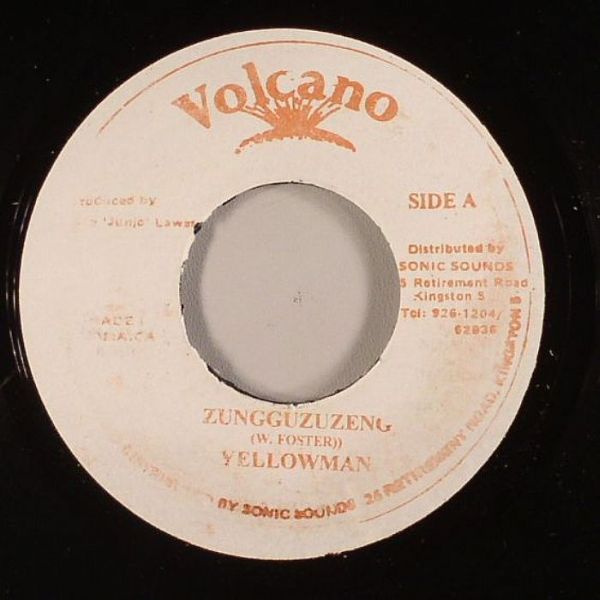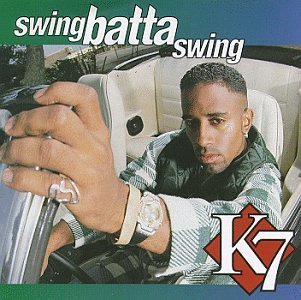Gotta love distributed research technics —




Thx to Mark Calaguas for a few more notches in the Zunguzung tree, including a slippery interpolation by Ninja Man on “Funeral Again.” And, get this, two uses by Nice & Smooth — in the same way, and on CONSECUTIVE TRACKS (?!) on the same album: “Nice & Smooth” and “Dope on a Rope.” Interestingly, they just rap over Yellowman’s repeated vocal loop, using it as another voice in the texture, something which didn’t really become common in hip-hop until the chipmunk funk of RZA and Kanye, et al. — and then still seemed avant-garde at times. I think this is partly possible because Yellowman is just chanting some enchanting nonsense (which would be true for many listeners even if he were rapping in patois). But it’s a pretty avant-garde move in its own way, especially to employ the loop on two songs in a row, as if it’s the funky drummer or some shit.




These latter uses, though, remind me of a very similar contemporary deployment & on a downright document of its day, “Zunga Zeng,” a hip-house, club/dance crossover jawn by ex-Latin-freestyle crooner Louis “Kayel” Sharpe (aka, K7), which, atop a digital sample of Yellowman’s catchy chorus, features some bizarre turns of phrase, flips of tongues, and uses of words. To wit:
Y yo te hablo
Como te gusta
I talk to ya
Just like you like it
Te toco eso
Como te gusta
A ragga Rasta!
Just like you like it
wayne & wax, “Zunga Zeng Shitty-Vinyl-Rip Mini-Mega-Mix”
(funmob>>extended>>diamond>>topdog)
[audio:http://wayneandwax.com/wp/audio/zungazeng_mix.mp3]




// dissertation snip //
Before embarking on a solo career, Kayel was one-third of the group TKA, a “Latin freestyle” trio, releasing the kind of synthesizer-heavy, electro-propelled dance pop and syrupy ballads that, as performed by acts such as Expose, the Cover Girls, and Lisa Lisa and Cult Jam, found large audiences in New York, New Jersey, and Miami. … In an interview with DJ Johnny Budz, Kayel himself calls TKA’s style “dance pop music,” but he also draws his musical genealogy more precisely when asked about hip-hop’s contributions, “Hip-Hop is the mother sound of Freestyle and R&B, and I grew up listening to that kind of music.” Indeed, the hip-hop influence, not to mention a healthy dose of dancehall, emerge much more audibly in Kayel’s work as a solo artist. K7’s debut, Swing Batta Swing, was a certified gold record, largely due to the popularity of “Come Baby Come,” a track that, with its gruff-toned, call-response vocals and catchy nonsense syllables — ba-dang-da-dang-da-dang-da-dada-dang-dang — was clearly informed by, and piggy-backed on the popularity of, the crossover-oriented dancehall (e.g., Shabba Ranks) which was finding traction in U.S. “urban” and pop markets at around the same time. A description in the All Music Guide affirms the perception of K7 as an act bringing together these stylistic threads: “New York City native K7 had success in the mid-’90s with his fusion of rap, dancehall, and dance.” The group’s Yellowman-sampling second single, “Zunga Zeng,” would have been widely heard as both an album cut and a minor club-anthem. Yellowman’s decade-old refrain would not have seemed at all out of place for the increasingly polyglot pop emerging from New York City at this time.
“Zunga Zeng” not only gives us a window into the continued penetration of reggae into the American pop vocabulary, it also demonstrates the particular production values of its day. Although we hear group harmonies and a prominent synthesizer melody, this is not the freestyle music of TKA. The sole synth-line, a high-pitched, wheezy melody, connects the production to the “G-Funk” that had come increasingly to define L.A.-based hip-hop and found widespread favor on Dr. Dre’s multi-platinum outing, The Chronic (1992). Although the beefed-up breakbeats — enhanced with synthesized drums and a booming bass reminiscent of the Roland TR-808 — underlying “Zunga Zeng” point to Dre’s production style as well (in particular, to the albums for N.W.A. and Eazy-E, whose “Nobody Move” [1988] also featured a sampled Yellowman refrain), the influence from West Coast hip-hop ends there. Despite its pop-sheen, the rest of the production fits easily alongside contemporary, N.Y.-based hip-hop, especially those songs, such as Naughty By Nature’s “O.P.P.” (1991), which also enjoyed some radio-play and sales-chart success. Between the “dusty,” well-worn breakbeats and the saxophone loops and more fragmentary jazz samples (recalling sample-based producer Pete Rock), “Zunga Zeng” typifies a particular kind of sample-heavy hip-hop production. Coming at the tail-end of hip-hop’s “Golden Age” when, still unbridled by the chill of copyright litigation, sampling practices ran rampant, such tracks often dazzle in their dense mix of musical signifiers. In this context, a Yellowman sample represents yet another layered reference in a rich world of recorded music ripe for such “plundering.” And yet, despite the leveling effect of such a motley mix, the choice to sample from a reggae song, and from “Zungazung” at that, represents a significant strategy. What we hear in K7’s music is a condensation of New York’s varied soundscape, but “Zunga Zeng,” as a pop-savvy song, does more than merely distill the city’s “sound”: it mobilizes a set of resonant figures, with reggae firmly (if distortedly) in the center, in order to strike a chord with contemporary listeners.
The presence of reggae signifiers in such an ephemeral yet widely heard track as K7’s “Zunga Zeng” further confirms, as it propels, the presence of Jamaican musical style in the American mainstream. As if to dispel any doubts about dancehall’s influence here, not only does “Zunga Zeng” contain a sample of Yellowman’s “Zungazung” (which includes not just the vocals, but the bass, drums, and other sounds of the original arrangement — all pitched/sped up), Kayel also peppers the recording with the same cliché interjections that also gave BDP’s music some of its Jamaican tinge, including the distinctively Jamaican stylizations of onomatopoeic gunfire (“Bo! Bo! Bo!” “Bddddrrrrap! Bddddrrrrap!”). Perhaps more telling is the appearance late in the song of the terms “ragga” and “Rasta” — two common signifiers (if empty ones in this case) of Jamaican-ness. Kayel pronounces the terms side-by-side, without any elaboration of their significance, suggesting that their employment here functions primarily — and revealingly — as a kind of play for authenticity, seeking to cement the vague but powerful sonic connections to reggae which otherwise operate at a more implicit level throughout the song. Interestingly, the references appear at a moment in the song (at around 3:00) when Kayel is otherwise rapping in Spanish, suggesting at once the foreignness of and familiarity with Jamaican language:
Y yo te hablo
Como te gusta
I talk to ya
Just like you like it
Te toco eso
Como te gusta
A ragga Rasta!
Just like you like it
This seemingly more explicit attempt to foreground the Jamaican-ness of “Zunga Zeng” seems as nonsensical (but nevertheless meaningful) as the scat-like syllables that begin the song. The collective response to these two relatively unrelated signifiers (save for their common Jamaican-ness), is, “just like you like it” — perhaps acknowledging the current vogue for dancehall style. The placement of these Jamaican terms after the translations that precede them, however, appears to create an odd equation: K7 juxtaposes “te toco eso” (trans., “I touch you there” or “I touch that [thing] of yours”) with “a ragga rasta,” which perhaps is to say, coyly, “this Jamaican-style music touches you, no?” Then again, maybe we should not make too much of this passing reference except to note that K7’s employment of such Jamaican terms appears at least to confirm their currency. After all, the song is a light bit of club fare: the lyrics are so much dance-pop doggerel — though remarkably bilingual given the American mainstream’s general intolerance of anything but English — rarely rising above such clichés as, “Move! / Come on, come on! / Hey ladies, let your bodies flow!”
Not atypical for a dance-pop (or even hip-hop) single, “Zunga Zeng” was released as an “extended mix” 12-inch including three remixes and an a capella vocal. The various remixes allow the record to appeal both to DJs in search of different, seemingly “exclusive” versions and to DJs within niche markets — such as Latin freestyle — who might not otherwise play the original version. The remixes illustrate K7’s cross-market strategy, linking stylistic features to demographic targets (e.g., mainstream/top-40 consumers, dance-floor denizens, the “Latin” market). At the same time, the multiple versions of “Zunga Zeng” also give Kayel an opportunity to demonstrate the breadth of styles that informs his sound and to make additional sonic (and thus social) connections. The “Diamond Mix” substitutes different samples but stays essentially within the same hip-hop/dance-pop style: a bluesy guitar line takes the place of the jazz fragments and sax riff, new (but again familiar) breakbeats provide the rhythmic drive, while a soul-jazz organ provides some occasional lift. On the “F.U.N Mob Remix,” orchestral “stabs” and vocal grunts flesh out the texture as yet another well-worn breakbeat (from Melvin Bliss’s “Synthetic Substitution”) serves as anchor. Occasionally, a freestyle-evoking bassline enters and some light synth percussion plays in right channel. Different from the other versions, the “F.U.N. Mob Remix” features the vocalists engaging in some call-and-response with the Yellowman sample toward the end, while a second breakbeat, on every other bar, adds to the percussive texture.
The “Top Dog Remix” is perhaps the most interesting of all. Beginning with spacey synth, followed by a programmed break and a slinky bass lick, the track quickly breaks into a synth-heavy workout, replaying, at a faster tempo than the original, the accompanimental track to Yarbrough & Peoples’ dancefloor classic, “Don’t Stop the Music” (1981). A clear and impressively faithful homage, the beat re-connects K7 to his freestyle roots via the sounds of electronic R&B, one of the major tributaries feeding the freestyle sound. On this mix, the Yellowman sample is gone in lieu of a group rendition of “zungazungungusunguzeng” since, presumably, the new texture is too dense to mix with the Yellowman sample (and its accompanying arrangement). Connecting further to the sounds of freestyle and electro (both of which frequentlt employed vocoder technology), some vocals on the “Top Dog Remix” are electronically-processed, including the chorus vocal, “I love to turn you on.” Fulfilling the tribute, there is a short bridge of sorts following the chorus, during which the texture and chord progression change substantially while a female voice sings a memorable (and, for hip-hop and R&B listeners, oft quoted) phrase from the Yarbrough & Peoples’ original: “I just wanna rock you, / all night long.” The short but faithful interpolation departs rather strongly from the rest of the song, but given the multiple references already at play here, it is easily reconciled within the intertextual world in which K7’s music revels.
// end transmission //
more soon, including the EMP paper, w/ audio —
“Come baby come” has embarassing canonical status for me as one of the constant-rotation-on-hot97-circa-1993 tracks that turned me on to hiphop at age 13. and so the K7 tune was the first thing I thought of when you said “Zunguzung”. It is excellent to see them put in context here.
i aint been skippin class, just sitting in the back with my hoodie… teach on
Nice pres. on this at EMP
Nice piece.
I happened to be listening to some tracks produced by Shondrae in this thread and I realized Petey Pablo’s “Vibrate” has a very similar “dang dadang dadang” to the “Come Baby Come” track: http://www.youtube.com/watch?v=8RUBEcOFMdA
Hahahahaha just realized Bas Rutten does the dangdadangadadang thing too: http://www.youtube.com/watch?v=D3K-mrlYG7Y
dang is right! double dang.
that’s some creative listening, for sure, but i hear what you’re saying.
man, that bas rutten dude is scary. funny, but scary.
thx for the links over at ohword, btw. i like what you guys got going over there.
FYI — I’ve posted the “full” Zunguzung paper (at least the version I offered at EMP and IASPM last month) here.